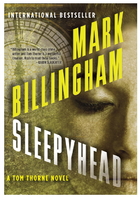INTRODUCTION
THE YEAR IS 1895. London is swathed in dense yellow fog. As the greasy clouds swirl up the streets and condense in oily drops on windowpanes, two men peer out from rented rooms at 22IB Baker Street. One is tall and gaunt with a narrow face, hawklike nose and high, intellectual brow. The other, shorter and stockier, is square-jawed and moustachioed. Outside, the smog envelops a vast city that holds a thousand sinister secrets but inside is a haven of comfort and bachelor domesticity. Suddenly, out of the surrounding gloom, a hansom cab emerges. A young woman descends from it, and looks up briefly at the two men at the window before ringing the doorbell of 22IB. Another client, with a tale of mystery and potential danger, has come to consult Sherlock Holmes. The game is once again afoot, and Holmes and Dr Watson will soon be in pursuit of the truth about another dark story from the hidden metropolis.
Few individuals in English history are as well known as Sherlock Holmes. From the moment in 1887 when, in a narrative published in Beeton's Christmas Annual for that year, his colleague and friend Dr John Watson revealed the detective's extraordinary powers of analysis and deduction, he captured the imagination of the public. As Watson continued to act as Holmes's Boswell, recording more of his exploits and adventures in magazine articles and books, his fame spread. Watson's accounts have been translated into dozens of languages, from Afrikaans to Yiddish, from Armenian to Vietnamese. Students of Swahili can read Mbwa wa Familia ya Baskerville. Those fluent in Slovak can turn the pages of Pes Baskervillsky. There are versions of the stories in Esperanto, in Pitman's shorthand and, of course, in Braille. There is even a translation of 'The Dancing Men' into the code that plays such a central role in that story.
Dramatized versions of Holmes's life began to appear in the 1890s and have continued to be performed to the present day. On any given day in 2005 an amateur dramatic society somewhere in England or America will be staging a play in which Sherlock Holmes makes an appearance. He has been the subject of hundreds of films from the early silent era to the present day. Sherlock Holmes — The Musical by Leslie Bricusse, screenwriter of the Dr Dolittle movie, opened in London in 1989. (Admittedly, it closed almost immediately and has rarely been seen on the stage since.) There has been a ballet called The Great Detective, produced at Sadler's Wells in 1953, and at least one opera has required a tenor Holmes and a bass Watson to sing feelingly of their mutually rewarding partnership and the joys of detective work.
Although Holmes has been dead for more than seventy years, people still write from around the world to ask for his help. Until recently Abbey House, the headquarters of the Abbey National Building Society, which stands on the site of his one-time lodgings in Baker Street, employed a secretary to answer the letters that were delivered to the address. Since his death in 1929, a growing army of Holmes scholars has produced a library of theses and dissertations on his life and work. In half the countries of the world there are Sherlock Holmes societies, their members dedicated to the minute examination of his life and work: the Singular Society of the Baker Street Dozen in Calgary, Canada; the Copenhagen Speckled Gang; Le Cercle Littéraire de l'Escarboucle Bleue in Toulouse; the Tokyo Nonpareil Club; the Ural Holmesian Society in Ekaterinburg; the Illustrious Clients of Indianapolis; the Friends of Irene Adler in Cambridge, Massachussetts; the Six Napoleons of Baltimore. All these and many more are devoted exclusively to the study of Sherlock Holmes. Even writers of fiction have taken the basic facts of his life and expanded them into novels and short stories of varying degrees of credibility.
Like other emblematic figures from the nation's past — Henry VIII, Robin Hood, Winston Churchill – he has been seized upon by the heritage industry. Pubs and hotels are named after him. Tours of Sherlock Holmes's London wind daily through the streets of the capital. Holmes memorabilia crowd the shelves of gift shops and tourist boutiques. Should you feel so inclined, it is possible to buy silver statuettes of Holmes and Watson, Sherlock Holmes fridge magnets, Hound of the Baskervilles coffee mugs, a 22IB Baker Street board game and a Sherlock Holmes plastic pipe designed to provide the authentic Holmes aura without actually encouraging smoking. There is even a Sherlock Holmes teddy bear dressed in an Inverness cape and deerstalker hat.
Yet Holmes himself remains a curiously elusive figure. Apart from a few monographs on arcane subjects (types of tobacco ash; the polyphonic motets of the Renaissance composer Orlande de Lassus; ciphers and secret writings) as well as a manual on beekeeping, he published nothing under his own name. In one narrative ('The Adventure of the Cardboard Box') Holmes claims to have published two short monographs on ears in the Journal of the Anthropological Institute but a trawl through nineteenth-century back numbers of that periodical suggests that he was referring to works that he had merely planned rather than completed. Two narratives of his work, which he wrote in the first person, were published in The Strand Magazine in 1926, three years before his death. Otherwise the record is blank. His preferred means of communication was the telegram, more impermanent in his time than the e-mail is today, and no irrefutably authentic letters written by him survive.
For any students of Holmes's life and work, the alpha and the omega of their research remain the texts written by his colleague and friend Dr John H. Watson. There are fifty-six short narratives and four longer ones, which all scholars and Holmesians agree are the work of Watson or (in two instances) Holmes. There are a few texts ('The Case of the Man Who Was Wanted', 'The Story of the Lost Special') that some commentators wish to claim for the canon but their status remains disputed. There are also those unidentified papers, which once, almost certainly, existed but which seem to have disappeared. 'Somewhere in the vaults of the bank of Cox & Company at Charing Cross,' Watson wrote in 'The Problem of Thor Bridge', 'there is a travel-worn and battered tin dispatchbox with my name upon the lid. It is crammed with papers, nearly all of which are records of cases to illustrate the curious problems which Mr Sherlock Holmes had at various times to examine.' Cox & Company's building in Charing Cross was destroyed in the London Blitz and, if there were still papers in the vault, a decade after Watson's death, they were lost in the conflagration.
It is always worth remembering just what a small proportion of Holmes's cases is recorded in Watson's surviving narratives. In The Hound of the Baskervilles Holmes refers in passing to the 'five hundred cases of capital importance which I have handled'. The events in the Baskerville case took place more than a decade before Holmes's supposed retirement and, as we shall see, more than thirty years before his actual and final retirement from all involvement in criminal investigation. Those thirty years saw well over a thousand further cases. From a total of approximately 1,800, Watson gave us accounts of sixty. In other words, only between 3 and 4 per cent of the extant cases are recorded by the doctor.
Yet the primary source for Holmes's life remains the work of Watson and, as Holmes scholars have long known, Watson's narratives, for a variety of reasons, have to be interpreted with care. Often Holmes himself muddied the waters by misleading Watson, providing him with false information and spurious facts that merely sent the doctor off in pursuit of red herrings. Often Watson deliberately obscures the truth, hiding real characters under pseudonyms or disguising towns and cities beneath invented names. Sometimes he is quite simply wrong. It is easy to forget the circumstances in which Watson wrote his narratives. Although, as he points out in 'The Adventure of the Solitary Cyclist', 'I have preserved very full notes of these cases,' and clearly he must have had his notes beside him as he wrote, the full stories that he handed over to Arthur Conan Doyle for publication were not produced until years, sometimes decades, after the events they describe. 'The Adventure of the Devil's Foot', for instance, shows Holmes investigating the macabre deaths in the Tregennis family whilst he was holidaying in Cornwall with Watson in the spring of 1897 but it was not written up in full until 1910. In the case of the investigation known as 'The Adventure of the Creeping Man', Watson is recalling events from 1903 but the story was not published for another twenty years, appearing in The Strand Magazine for March 1923. In these circumstances it is not surprising that Watson occasionally slipped up. Even the most egregious errors – setting one of the stories at a time when Holmes was assumed to be dead, for example – become understandable to a degree.
Despite the difficulties imposed by the shortage of authentic records, few Victorian lives deserve study as much as does that of Sherlock Holmes. And a Victorian he undoubtedly was. Although he was only in his late forties when Victoria died, he remained rooted in the world into which he was born and in which he grew up. We think we know the Victorians. In contrast to our contradictory selves, grappling with the complexities of modernity and post-modernity, they seem the products of a simpler era. Frozen in the clichéd poses we have imagined for them, the Victorians appear immune to the fears and anxieties that trouble us. Staring at us from sepia-tinted photographs, they look certain of the world and their own place in it in a way that we cannot hope to match. Nothing, however, could be further from the truth. Anyone born, like Holmes, in the 1850s and growing up in the late Victorian era, lived through a period of intellectual and social upheaval just as dramatic and threatening as any the twentieth century was to offer. Religious beliefs were crumbling under the assault of new theories of man and his place in the world. The British Empire, on which the sun was supposed never to set, may have appeared to be everlasting but the seeds of its ultimate collapse had already been sown. Germany and America had emerged as its competitors on the world stage. New ideologies – socialism, communism, feminism – began to shake the foundations of state and family on which Victorian confidence and security were built. Scratching the surface of Victorian complacency soon reveals the underlying angst about a world that was changing rapidly and unpredictably.
The ambiguities of Holmes's character mirror those of the age in which he came to maturity. Highly rational and committed to the idea of progress, he was haunted by darker dreams and more troubling emotions. Drawn into the service of an empire that he knew, intellectually at least, had already passed its zenith, he remained steadfast in his commitment to it. Yet, even as he fought to preserve stability and the solid values of the age, he himself was driven by a lifelong search for change, stimulation and excitement. His own innermost beliefs – social, aesthetic, scientific – often clashed with those that he outwardly professed. To follow Holmes through the twists and turns of his career in the 1880s and 1890s is to watch the Victorian era battling with its own demons.















